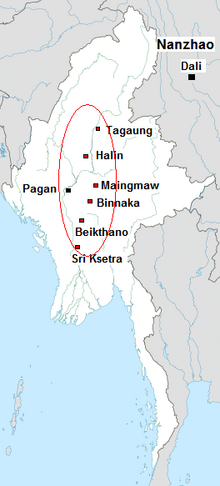Pyu language (Sino-Tibetan)
| Pyu | |
|---|---|
| Region | Pyu city-states, Pagan Kingdom |
| Extinct | 13th century |
| Language codes | |
| ISO 639-3 | pyx |
pyx | |

The Pyu language (Burmese: ပျူ ဘာသာ, IPA: [pjù bàðà]; also Tircul language) is an extinct Tibeto-Burman language, mainly spoken in present day central Burma (Myanmar) in the first millennium CE. It was the vernacular of the Pyu city-states which thrived between the second century BCE and the 9th century CE. Its usage declined, starting in the late 9th century when the Mranma (Burmans) of the Nanzhao Kingdom began to overtake the Pyu realm. The language was still in use, at least in royal inscriptions of the Pagan Empire, if not in popular vernacular, until the late 12th century. It became extinct in the 13th century, completing the rise of Burmese language, the language of the Pagan Empire, in Upper Burma, the former Pyu realm.[1]
The Pyu script was based on a number of Brahmi scripts. Latest scholarship, though yet not settled, suggests that the Pyu script may have been the source of the Burmese script.[2]
Classification
The Pyu language was a Tibeto-Burman language, believed to be related to Old Burmese[3] though the degree of proximity is still debated. The language is tentatively classified within the Lolo–Burmese languages by Matisoff, and thought to most likely be Luish by Bradley. Van Driem feels it is best treated as an independent branch of Tibeto-Burman pending further evidence.[4]
Usage
The language was the vernacular of the Pyu states. But Sanskrit and Pali appeared to have co-existed alongside Pyu as the court language. The Chinese records state that the 35 musicians that accompanied the Pyu embassy to the Tang court in 800–802 played music and sang in the Fan (Sanskrit) language.[5]
Notes
References
- "Pyu language". Linguist List. Eastern Michigan University. Retrieved 2011-11-13.
- Aung-Thwin, Michael (2005). The mists of Rāmañña: The Legend that was Lower Burma (illustrated ed.). Honolulu: University of Hawai'i Press. ISBN 978-0-8248-2886-8.
- Harvey, G. E. (1925). History of Burma: From the Earliest Times to 10 March 1824. London: Frank Cass & Co. Ltd.
- Htin Aung, Maung (1967). A History of Burma. New York and London: Cambridge University Press.
